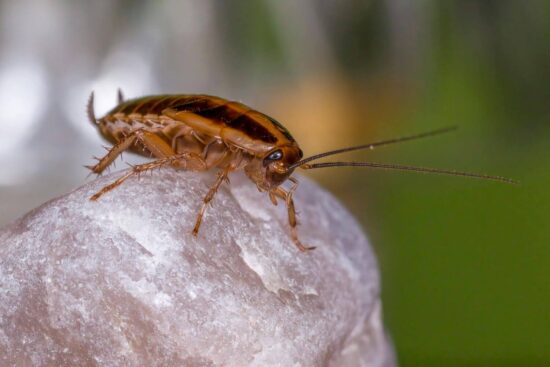Nobody wants to see a cockroach scurrying across their kitchen floor. These unwelcome guests can turn a peaceful evening into a nightmare and make any homeowner feel grossed out. The good news is that understanding what attracts roaches can help you keep them away from your home for good.
Cockroaches are surprisingly simple creatures. They only need three basic things to survive: food, water, and a safe place to hide. When your home provides these essentials, it becomes like a five-star hotel for roaches. By learning about the specific things that make cockroaches want to move in, you can take steps to make your home much less appealing to these unwanted pests.
Let’s look at the main things that attract cockroaches to homes and what you can do to eliminate each one.
1. Food Crumbs and Leftover Meals
Even the tiniest crumb can attract cockroaches from quite a distance. These pests have an amazing sense of smell that lets them detect food sources you might not even notice. A few breadcrumbs on the counter or a spilled drop of sauce can signal to roaches that your kitchen is worth visiting.
Cockroaches aren’t picky eaters either. They love sweet foods, meat, and anything with starch like bread or pasta. Open containers, unsealed cereal boxes, and even tiny food particles stuck to plates can all attract cockroaches to your home.
The best way to prevent this problem is to clean up immediately after cooking or eating. Wipe down all surfaces, sweep the floor, and store food in containers with tight lids. Making this a daily habit will remove one of the biggest reasons roaches want to visit your kitchen.
- Starts killing roaches within hours and eliminates nests
- Lasts up to 12 months with child-resistant bait stations
- Easy to use, no mess or strong odors
- Targets roaches you see and the hidden ones too
2. Dirty Dishes in the Sink
Leaving dirty dishes in the sink overnight is like hanging up a welcome sign for cockroaches. Even if the dishes look mostly clean, tiny bits of food and grease can still cling to plates and glasses. Roaches have such a strong sense of smell that they can detect these microscopic food particles.
The problem gets worse if you let dishes pile up for several days. The longer food sits on dishes, the stronger the smell becomes, and the more likely you are to attract cockroaches. Even a single glass with dried milk residue can be enough to draw these pests into your kitchen.
Make it a rule to wash dishes right after eating, or at least rinse them thoroughly if you plan to wash them later. Running your dishwasher daily also helps eliminate any food smells that might attract roaches.
3. Standing Water and Moisture
Water is just as important to cockroaches as food. These pests can actually survive much longer without food than they can without water. Any source of moisture in your home can become a magnet for roaches looking for a drink.
Common water sources that attract cockroaches include leaky pipes under sinks, dripping faucets, pet water bowls left out overnight, and even damp sponges sitting by the sink. Bathrooms are especially attractive to roaches because of the constant humidity from showers and baths.
Fix any leaks as soon as you notice them, and make sure to dry your sink and counters before going to bed. Empty pet water bowls at night, and use a dehumidifier in basements or other damp areas of your home.
4. Warm Electronic Devices and Appliances
Cockroaches love warmth, which makes electronic devices perfect hiding spots. Items like televisions, computers, gaming consoles, and internet routers all produce heat when they’re running. This warmth creates an ideal environment for roaches to hide and even lay eggs.
Kitchen appliances are especially problematic because they combine warmth with potential food sources. Roaches commonly hide behind refrigerators where the motor produces heat, inside toaster ovens, and even in coffee makers. The combination of warmth and food crumbs makes these appliances irresistible to cockroaches.
Keep electronics clean and use compressed air to blow out keyboards and other devices regularly. Avoid eating near computers or gaming systems, and clean behind large appliances like refrigerators and stoves at least once a month.
5. Grease and Cooking Oil
Cockroaches go crazy for anything greasy or oily. Even a thin film of grease around your stove hood or a few drops of cooking oil on the counter can attract cockroaches to your kitchen. These pests are drawn to grease because it’s high in fat and provides lots of energy.
Leftover cooking oil, greasy pans, and even the buildup of oil on your stove can all become food sources for hungry roaches. The smell of grease travels far and can bring cockroaches from other parts of your home or even from outside.
Clean your cooking surfaces thoroughly after each use, and wipe down your stove and oven hood regularly. Dispose of cooking oil properly instead of pouring it down the drain, and clean greasy dishes right away rather than letting them sit.
6. Cardboard Boxes and Paper Products
This might surprise you, but cockroaches actually eat cardboard and paper. The fibers in these materials provide nutrition that roaches can survive on when other food is scarce. The glue used to make cardboard boxes often contains animal products, making it even more attractive to these pests.
Cardboard storage boxes that sit undisturbed in attics, basements, or garages are perfect homes for cockroaches. Old newspapers, magazines, and book collections can also attract cockroaches looking for both food and shelter.
Replace cardboard storage boxes with plastic containers whenever possible. Recycle newspapers and magazines promptly instead of letting them pile up, and always inspect packages and boxes before bringing them inside your home.
7. Pet Food and Water Bowls
Pet food is just as appealing to cockroaches as human food. Many pet foods are high in protein and fat, making them perfect meals for hungry roaches. Leaving pet food bowls out overnight gives cockroaches easy access to a reliable food source.
Water bowls are equally problematic since cockroaches need water to survive. A constantly filled pet water bowl becomes like a neighborhood watering hole for roaches and other pests.
Feed your pets at specific times rather than leaving food out all day. Remove both food and water bowls at night, and store pet food in sealed containers rather than leaving it in the original bag.
- Starts killing roaches within hours and eliminates nests
- Lasts up to 12 months with child-resistant bait stations
- Easy to use, no mess or strong odors
- Targets roaches you see and the hidden ones too
8. Garbage and Compost
Garbage cans are like all-you-can-eat buffets for cockroaches. The combination of food scraps, moisture, and strong smells makes trash irresistible to these pests. Even small amounts of food waste can attract cockroaches from quite a distance.
Compost piles and outdoor garbage areas create the same problem. The smell of rotting food travels far and signals to roaches that there’s plenty to eat nearby. Indoor trash cans without tight lids are especially problematic.
Take your garbage out regularly, ideally every few days rather than waiting for it to get completely full. Use trash cans with tight-fitting lids, and keep outdoor garbage cans as far from your house as possible. If you compost, keep the pile well away from your home’s exterior.
9. Dark, Cluttered Hiding Places
Cockroaches hate bright lights and prefer to hide in dark, undisturbed areas during the day. Cluttered spaces provide perfect hiding spots where roaches can feel safe and secure. Storage rooms, basements, and areas behind furniture all make ideal cockroach hideouts.
Piles of clothing, stacks of books, and collections of random items create the perfect environment for roaches to hide and breed. These areas often go undisturbed for long periods, giving cockroaches time to establish themselves without being detected.
Keep your home as organized as possible, and declutter regularly. Store items in sealed containers rather than leaving them in piles, and clean behind furniture and appliances periodically to eliminate potential hiding spots.
10. Cracks, Gaps, and Entry Points
Understanding what attracts roaches is only half the battle if they can easily get into your home in the first place. Cockroaches can squeeze through incredibly small spaces, sometimes as narrow as the thickness of a dime. Foundation cracks, gaps around pipes, and spaces under doors all provide easy entry points.
These pests often travel between rooms and even between apartments through walls, ceilings, and utility openings. A small gap that seems insignificant to humans can be a superhighway for cockroaches.
Inspect your home regularly for cracks and gaps, and seal them with caulk or foam. Install door sweeps under exterior doors, and use weatherstripping around windows. Pay special attention to areas where pipes or wires enter your home.
11. Plumbing and Drain Systems
Drains and pipes provide cockroaches with both entry points and essential resources. These areas are usually dark and moist, creating perfect conditions for roaches to thrive. Bathroom and kitchen drains are especially attractive because they often contain organic matter that cockroaches can eat.
Leaky pipes create constant moisture sources that attract cockroaches looking for water. The area under your kitchen sink or bathroom vanity can become a cockroach paradise if pipes are dripping or if there’s standing water.
Keep drains clean and consider using drain covers to prevent roaches from entering through plumbing. Fix any leaky pipes immediately, and check under sinks regularly for signs of moisture or pest activity.
12. Strong Food Odors and Scents
Cockroaches use their sense of smell to locate food sources, and strong odors can attract cockroaches from surprising distances. Cooking smells, garbage odors, and even some pleasant scents can signal to roaches that food is nearby.
Surprisingly, things like scented candles, potpourri, and heavily fragranced cleaning products can sometimes attract cockroaches because the chemicals can smell like food to these pests. Even dirty laundry can create odors that roaches find appealing.
Use airtight containers to control food odors, and clean up cooking smells by using exhaust fans and wiping down surfaces. Be mindful of strong scents throughout your home, and store heavily fragranced items in sealed containers.
13. Alcoholic Beverages
Beer, wine, and other alcoholic drinks can attract cockroaches because of their sugar content. The fermentation process creates smells that roaches find appealing, and spilled alcohol can become a food source for these pests.
Open bottles or cans left sitting out overnight are especially problematic. Even small amounts of alcohol spilled on counters or floors can draw cockroaches to the area.
Cover alcoholic beverages when not in use, and clean up any spills immediately. Rinse bottles and cans before storing them, and avoid leaving drinks sitting out overnight.
14. Furniture and Upholstered Items
Cockroaches can make themselves comfortable in your furniture, especially if you tend to eat while watching TV or relaxing on the couch. Food crumbs that fall between cushions create hidden food sources that can attract cockroaches to your living areas.
Upholstered furniture also provides excellent hiding spots for roaches and can even become nesting sites where they lay eggs. The fabric itself can serve as a food source since cockroaches can digest certain organic materials.
Vacuum furniture regularly, including between and under cushions. Avoid eating in areas with upholstered furniture, and inspect furniture periodically for signs of pest activity or egg cases.
15. Neighboring Infestations
Sometimes the answer to what attracts roaches to your home might actually be coming from next door. If your neighbors have a cockroach problem, there’s a good chance these pests will eventually make their way to your home too, especially in apartment buildings or row houses.
Cockroaches can travel through shared walls, common plumbing systems, and small gaps between units. Even if you keep your home perfectly clean, you might still end up with roaches if they’re spreading from nearby infestations.
Seal any gaps in shared walls, and communicate with neighbors about pest issues when appropriate. In apartment buildings, work with property management to address building-wide pest control needs.
The Key to Keeping Roaches Away
The most important thing to remember is that cockroaches are simple creatures looking for basic necessities. They want food, water, warmth, and shelter. When you eliminate these attractants, you make your home much less appealing to roaches.
Effective cockroach prevention requires addressing multiple attractants at the same time. It’s not enough to just clean up food if you still have moisture problems and hiding places. The best approach combines good sanitation, moisture control, elimination of hiding spots, and sealing entry points.
Remember that even clean homes can attract cockroaches if the right conditions exist. Don’t feel embarrassed if you spot a roach in your home. Instead, use this information to identify what might be drawing them in and take steps to eliminate those attractants.
By understanding what makes cockroaches want to visit your home and taking consistent action to remove these attractions, you can keep these unwanted pests away and maintain a comfortable living environment for you and your family.



